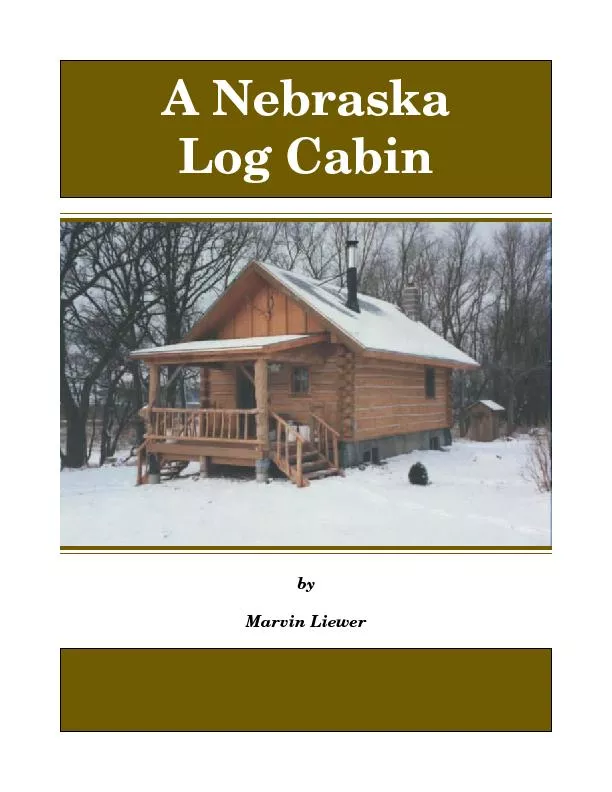/


byMarvin Liewer 3 by Drew Langser I selected this method as it seemed the best procedurebottom of the log This crackment has a poured concrete 5 Roof ConstructionI constructed the triangular gable e ID: 289926
Download Pdf The PPT/PDF document "A NebraskaLog Cabin" is the property of its rightful owner. Permission is granted to download and print the materials on this web site for personal, non-commercial use only, and to display it on your personal computer provided you do not modify the materials and that you retain all copyright notices contained in the materials. By downloading content from our website, you accept the terms of this agreement.
A NebraskaLog Cabin byMarvin Liewer 3 by Drew Langser. I selected this method as it seemed the best procedurebottom of the log. This crackment has a poured concrete 5 Roof ConstructionI constructed the triangular gable ends the same as one would for a conventional balloon framedhouse. Two x six studs were placed on two foot centers and covered with plywood on the outsideand sheetrock on the inside. This is a simpler technique than stacking logs to form a triangle. The roof can be constructed much the same as a conventional house using pre-constructedtrusses or rafters and ceiling joists. Plywood sheeting would cover the roof with sheetrock in-stalled for the ceiling. Insulation would be placed above the ceiling. walls at each end and two 8" x 8" hewed beam trusses on eight foot centers. Preconstructed 6 panels consisting of 7 ½ inches of rigid foam insulation bonded to ½ inch oriented strand board(OSB) were placed on the roof framing. These panels were four feet wide and thirteen feet longand spanned the distance from the ridge beam to the eave. Structural support for the panelswhich spanned the distance for the ridge beam to the top log was built into the panel. The panelsresulted in a good solid roof with an insulation value of R-30.ChinkingChinking the logs properly is an important step to insure that the walls are tight and draft free.Pioneer log homes were often chinked with a mixture of clay and straw. Mortar was also used.Many walls were later covered with plaster on the interior and boards on the exterior.Today synthetic compounds that flex as the logs shrink and swell with changing weather arecommonly used. A foam backing is used behind the chinking material which, in effect, results ina double seal on both the inside and the outside wall. Fiberglass insulation is placed in the spacebetween the foam backing materials. Two readily available chinking products are Perma-chinkand Log Jam. They are used in almost all commercially built log homes and are available infive gallon buckets. Instructions for applying of these products is supplied with the products. Iused Log Jam and had very good results.StainingMany different kinds of stains are available for finishing the inside and outside of the logs. It isimportant to make sure the log stain used is compatible with the chinking material. The chink-ing may not bond with some of the stains available. Fiberglass insulation Log Jam or Perma-chink Foam backer rod 7 Windows and DoorsGreen logs shrink as they dry and consequently the log walls will settle with time. Most of thesettling occurs within the first year, but minor settling will occur for 3 or 4 years. The log wallsof my cabin settled 2.5 inches the first year and approximately ½ inch since then. One mustwith the walls.The easiest way to frame door and window openings in log structures is to nail appropriate sizeddimensional lumber, i.e. 2 x 6s for 6" walls, directly to the ends of the logs to create a box. Thedrawback is that as the logs season and shrink in diameter, the walls settle at the corners, butsince the logs are nailed to a rigid frame at the windows, they cant settle at that junction. Thelogs will tend to pull away from the windows and create gaps allowing drats into an otherwisetight structure. To compensate for this settling, one can delay installing windows until the logshave dried. I recommend two years or more.I elected to frame the openings in such a manner that the logs are allowed to settle. First, Iplaced nominal 2 x 4 inch splines on each side of the window and door openings. The splines (orwooden uprights) were mortised into the ends of the logs. Then nominal 2 x 6s were fastened tothe splines, rather than the ends of the logs, thus framing the left and right side of the window/door openings. Next, 2 x 6s were placed across the top of the window/door opening leaving a gapof 3 inches between the frame and the log above. This gap was later filled in after the logs hadsettled. The 2 x 6 at the bottom of the frame can be nailed directly to the log at the bottom of thewindow opening. Conventional windows were installed in the 2x6 inch framed openings. Mortise 1.5 x 3.5 (dimension of 2 x 4) 8 to prolonged wetness. Common points of failure of wood structures is where water drips from thelower logs. The bottom log should be at least 12 inches above the ground. The roof at both the1.Store logs out of direct sunlight and in a manner that allows full air circulation prior to2.Apply a preservative treatment such as Penetreat as soon as logs are peeled. Apply again3.Construct on a foundation at least 12 inches above ground and construct the roof with long4.Allow for settling above the window and door frames or delay installation for one to two years.5.Follow the manufacturers directions for chinking and make sure the chinking is compatible6.Finish the logs with stain designed for log homes.My cabin has been my primary home sinceComfort in both winter and summer havethat brings peace and contentment. 10 by Charles McRaven. Ave. Perma-chink System, Inc.1605 Prosser Rd.Knoxville, TN 379141-877-244-6548Premier Building SystemsMid-AmericaRR!, Box 101Mead, NE 680411-800-228-4412